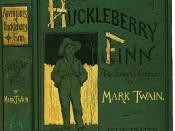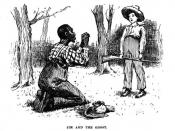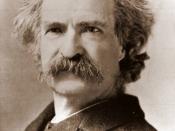Compare and contrast Tom and Huck. Consider why Twain uses Tom in the beginning and the end of the novel.
"Tom told me what his plan was, and I see in a minute it was worth fifteen of mine for style, and would make Jim just as free a man as mine would, and maybe get us all killed besides. So I was satisfied, and said we would waltz in on it" (232).
Mark Twain's The Adventures of Huckleberry Finn details the journey of Huckleberry Finn and a run away slave Jim. Huckleberry Finn's blind trust in his friend Tom Sawyer's plans have led Huck to some strange situations. As seen in the Sunday school "Arab" fiasco, where Tom, Huck and their gang attacked a Sunday school picnic, Huck accepts Tom's imagination as fact and disregards his own logic. Tom's reliance on the rules is more for style than to do what is moral.
In sharp contrast to Tom's rule-following attitude, Huck relies on his own intuition to make decisions. This clash between romanticism and realism is prevalent throughout the book. Tom Sawyer and his grandiose plans represent Romanticism, characterized by a belief in the ideal, whereas Huck represents realism or the viewing of everything as it actually is, without idealization. Twain also uses the characters of Huck and Tom to represent a conflict between Romanticism and Realism, as well as a conflict between Society and Freedom. In The Adventures of Huckleberry Finn, Mark Twain contrasts the characters of Tom and Huck to contrast Romanticism and Realism, as well as Society vs. Freedom in both the beginning and end of the novel to highlight the maturation of Huck.
Tom Sawyer was born and raised middle class. As such, Tom has access to a stable family life as well as...


